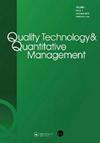基于随机初始退化水平和随机阈值的伽玛过程退化建模
IF 3
2区 工程技术
Q3 ENGINEERING, INDUSTRIAL
Quality Technology and Quantitative Management
Pub Date : 2023-01-08
DOI:10.1080/16843703.2022.2146904
引用次数: 0
摘要
性能特征的随机建模是产品质量评价的重要方法。作为随机建模的一部分,可以考虑不同的变化源,如时间、单位间异质性和测量误差。这些来源已纳入不同的随机过程在文献中。考虑到单位间的异质性,对于某些产品可以发现两个变异来源,特别是当初始水平和临界阈值因单位而异时。虽然这些来源已分别研究过,但没有同时研究过。本文提出了一种考虑时间不确定性、初始退化水平和临界阈值水平作为两个附加变化源的伽马过程建模方法。建模包括首先通过反褶积运算获得临界阈值与初始水平相减的分布。然后,通过数值积分得到一次通过时间分布的累积分布函数。通过仿真研究来评估该方法的性能,并对不同的场景进行了分析。此外,将该方法应用于疲劳裂纹扩展案例研究,并从中进行可靠性评估。本文章由计算机程序翻译,如有差异,请以英文原文为准。
Degradation modeling based on the gamma process with random initial degradation level and random threshold
ABSTRACT The stochastic modeling of performance characteristics is an important approach for the quality assessment of products. As part of the stochastic modeling, it is possible to consider different variation sources such as temporal, unit-to-unit heterogeneity and measurement error. These sources have been incorporated into different stochastic processes in the literature. Considering the unit-to-unit heterogeneity, two sources of variation can be found for certain products, particularly when the initial level and the critical threshold vary from unit-to-unit. Although, these sources have been studied separately, they have not been studied simultaneously. In this paper, a modeling approach is proposed which considers the gamma process to take into account the temporal uncertainty and the initial degradation level and the critical threshold level as two additional sources of variation. The modeling consists in first obtaining the distribution of the subtraction of the critical threshold and the initial level via a deconvolution operation. Then, the cumulative distribution function of the first passage time distribution is obtained through numerical integration. A simulation study is conducted to evaluate the performance of the proposed method, where different scenarios are analyzed. Furthermore, this approach is applied to a fatigue-crack propagation case study, from which a reliability assessment is performed.
求助全文
通过发布文献求助,成功后即可免费获取论文全文。
去求助
来源期刊

Quality Technology and Quantitative Management
ENGINEERING, INDUSTRIAL-OPERATIONS RESEARCH & MANAGEMENT SCIENCE
CiteScore
5.10
自引率
21.40%
发文量
47
审稿时长
>12 weeks
期刊介绍:
Quality Technology and Quantitative Management is an international refereed journal publishing original work in quality, reliability, queuing service systems, applied statistics (including methodology, data analysis, simulation), and their applications in business and industrial management. The journal publishes both theoretical and applied research articles using statistical methods or presenting new results, which solve or have the potential to solve real-world management problems.
 求助内容:
求助内容: 应助结果提醒方式:
应助结果提醒方式:


